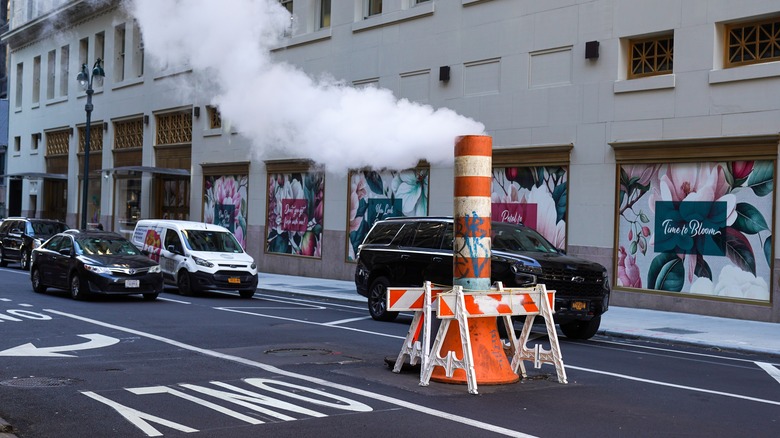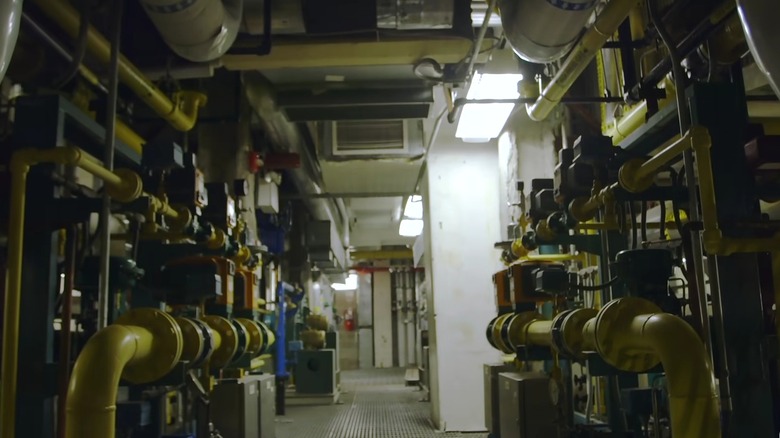Why Do You See Steam Rising From New York Roads?
Both hot steam and vapor rise from underneath the streets of The Big Apple, and Con Edison's massive 105 miles of subterranean piping is responsible. The steam running through the pipes is over 350 degrees Fahrenheit and is clean, usually made from the city's drinking water. Speaking of H2O, many people still aren't drinking enough of it, but fortunately, the best smart water bottles can ensure you stay hydrated, even on the go.
In Manhattan, if you see a tall orange and white chimney rising into the air from the street, it's likely due to maintenance or repairs on the piping. The purpose of the chimney, is to release hot steam higher into the air, so it doesn't come into direct contact with pedestrians or traffic.
However, if you see what looks like steam emanating from manhole covers, it's actually just vapor, created by moisture coming into contact with the scalding pipes underground, and it isn't hot.
The steam supplies almost 2,000 buildings with energy
The purpose of these steam pipes is that, instead of each high-rise running its own boiler, which would result in a skyline populated with rows of unsightly chimney's, Con Edison and its five power plants do all the heavy lifting. Massive boilers from these energy plants create steam that is then pumped underneath Manhattan specifically, to be used for heating and air conditioning.
Many buildings in New York, such as high-rise apartment blocks, utilize steam radiators to heat the space. The steam is supplied underneath the building and, because it rises naturally, is then distributed to all the different spaces for warmer temperatures during the winter. Air conditioning works a bit differently, where essentially the motor used to create cold air is powered by steam rather than electricity.
Some of the more notable customers of this steam are places like the Metropolitan Museum of Art and the Guggenheim, which utilize it to control humidity levels that help preserve art exhibits. It isn't just museums that find the steam useful, many restaurants in the Manhattan area use Con Edison to power their dishwashing machines. Manhattan is known for its fine dining establishments with Michelin star ratings, but some of you might be wondering, what does the Michelin star restaurant rating have to do with a tire company?
New York City has the largest steam network, but it isn't without its dangers
The idea of underground steam pipes supplying energy isn't exclusive to Manhattan, as there are other examples throughout the world, like Europe's biggest system, found in Paris, France. However, the sheer scope of New York's network of pipes completely overshadows anything else on Earth. Saumil Shukla, VP of Steam Operations at Con Edison in a YouTube video from The New York Times explained that, "If you took the next nine [biggest] steam systems and added them together, New York's steam system is still the largest."
However, these subterranean pipes began being installed all the way back in 1882, and after nearly a century and a half, require significant upgrades. While rare, there have been underground explosions from these steam pipes, which not only have caused bodily harm at the street level, but have also potentially exposed residents to toxic materials such as asbestos.
In fact, as Reuters reported, in 2018, a steam pipe ruptured sending asbestos into the air which caused nearly 50 buildings in the area to evacuate. To be fair, the hazards of asbestos weren't fully understood until around the 1970s, when it started being scaled back. Unfortunately, asbestos is just one example of surprisingly deadly technology throughout history.


